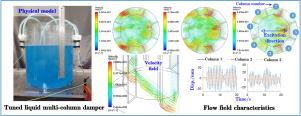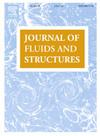On the characteristics of fluid flow field and oscillatory response of tuned liquid multi-column dampers
IF 3.4
2区 工程技术
Q1 ENGINEERING, MECHANICAL
引用次数: 0
Abstract
The tuned liquid column damper (TLCD) operates as a fluid counterpart to a tuned mass damper (TMD), harnessing the dynamics of liquid flow to effectively counteract unwanted vibrations, thereby achieving the stability within the structural system. Most recently, to overcome the shortcoming that conventional TLCDs can only control the vibration of structures in a single direction, a toroidal tuned liquid multi-column damper (TLMCD) was proposed and its control effectiveness was preliminarily validated. However, the hydrodynamic characteristics of the TLMCD remain elusive and warrant further clarification. Therefore, this study employs computational fluid dynamics (CFD) methodology to meticulously simulate the intricate three-dimensional multiphase flow dynamics within toroidal TLMCDs across a spectrum of excitation conditions, aiming to elucidate their hydrodynamic behaviors. The efficacy of the CFD-based simulation approach is validated through a comparative analysis of numerically computed and experimentally measured liquid displacement responses. The error magnitude of the simplified theoretical model for toroidal TLMCDs is assessed by comparing the outcomes derived from CFD simulations with the theoretical predictions. Furthermore, by visualizing the spatial and temporal distribution of fluid flow field, the three-dimensional fluid flow properties of toroidal TLMCDs are characterized. The findings presented highlight the frequency-dependent nonlinear characteristics of liquid column oscillatory responses, providing a valuable benchmark for the development of more refined theoretical models and guiding the optimization of fluid-type dampers.

论调谐液体多柱阻尼器的流场特性和振荡响应
调谐液柱阻尼器(TLCD)是一种与调谐质量阻尼器(TMD)相对应的流体阻尼器,利用液体流动的动力学特性有效抵消不必要的振动,从而实现结构系统的稳定性。最近,为了克服传统 TLCD 只能控制结构单向振动的缺点,有人提出了环形调谐液体多柱阻尼器(TLMCD),并初步验证了其控制效果。然而,TLMCD 的流体动力学特性仍然难以捉摸,需要进一步阐明。因此,本研究采用计算流体动力学(CFD)方法,细致模拟了环形 TLMCD 在各种激励条件下复杂的三维多相流动力学,旨在阐明其流体动力学行为。通过对数值计算和实验测量的液体位移响应进行对比分析,验证了基于 CFD 模拟方法的有效性。通过比较 CFD 模拟结果和理论预测结果,评估了环形 TLMCD 简化理论模型的误差幅度。此外,通过对流体流场的空间和时间分布进行可视化,还对环形 TLMCD 的三维流体流动特性进行了描述。研究结果突出了液柱振荡响应的频率非线性特征,为开发更精细的理论模型和指导流体型阻尼器的优化提供了宝贵的基准。
本文章由计算机程序翻译,如有差异,请以英文原文为准。
求助全文
约1分钟内获得全文
求助全文
来源期刊

Journal of Fluids and Structures
工程技术-工程:机械
CiteScore
6.90
自引率
8.30%
发文量
173
审稿时长
65 days
期刊介绍:
The Journal of Fluids and Structures serves as a focal point and a forum for the exchange of ideas, for the many kinds of specialists and practitioners concerned with fluid–structure interactions and the dynamics of systems related thereto, in any field. One of its aims is to foster the cross–fertilization of ideas, methods and techniques in the various disciplines involved.
The journal publishes papers that present original and significant contributions on all aspects of the mechanical interactions between fluids and solids, regardless of scale.
 求助内容:
求助内容: 应助结果提醒方式:
应助结果提醒方式:


